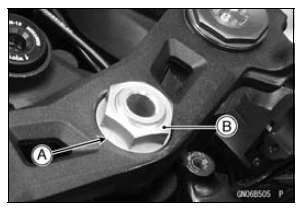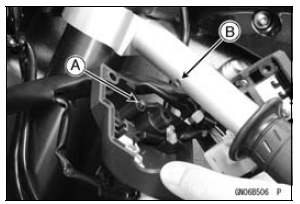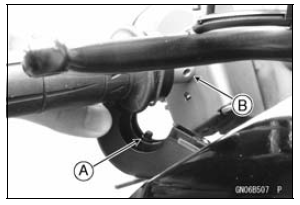

Apply a non-permanent locking agent to the threads of the handlebar positioning bolts and tighten them.
Torque - Handlebar Positioning Bolts: 9.8 N┬Ęm (1.0 kgf┬Ęm, 87 in┬Ęlb)
NOTE
Tighten the steering stem head bolt before tightening the upper front fork clamp bolts and handlebar clamp bolts.

| WARNING If the handlebar does not turn to the steering stop it may cause an accident resulting in injury or death. Be sure the cables, harnesses and hoses are routed properly and do not interfere with handlebar movement (see Cable, Wire, and Hose Routing section in the Appendix chapter). |
Fit the projection [A] into a hole [B] in the handlebar.
Torque - Switch Housing Screws: 3.5 N┬Ęm (0.36 kgf┬Ęm, 31 in┬Ęlb)

Fit the projection [A] into a hole [B] in the handlebar.

 Handlebar Removal
Handlebar Removal Frame
FrameCrankshaft Main Bearing
Insert/Journal Wear Inspection
Split the crankcase (see Crankcase Splitting).
Cut strips of plastigage to journal width.
Place a strip on each journal parallel to the crankshaft
installed in the correct position.
Tighten the crankcase bolts to the specified torque (see
Crankcase Assembly).
NOTE
Do not turn ...
Vehicle-down Sensor Input Voltage Inspection
NOTE
Be sure the battery is fully charged.
Turn the ignition switch to OFF.
Disconnect the vehicle-down sensor connector and connect
the measuring adapter [A] between these connectors
as shown in the figure.
Main Harness [B]
Vehicle-down Sensor [C]
Special Tool - Measuring Adapte ...
Clutch Cover Assembly
Replace the needle bearings and oil seal with new ones.
NOTE
Install the needle bearings so that the manufactureŌĆÖs
mark face out.
Install the needle bearings [A] and oil seal [B] position as
shown in the figure.
Press the upper and lower bearings so that the bearing
surface [ ...